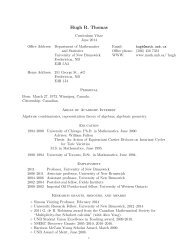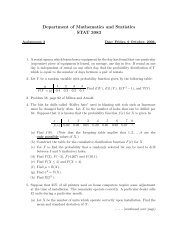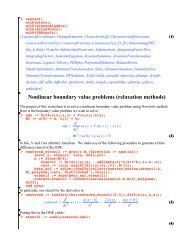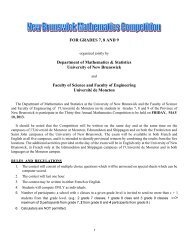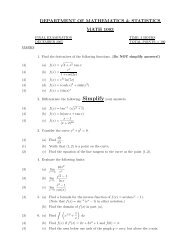1999 Maritime Mathematics Competition Solutions
1999 Maritime Mathematics Competition Solutions
1999 Maritime Mathematics Competition Solutions
- No tags were found...
Create successful ePaper yourself
Turn your PDF publications into a flip-book with our unique Google optimized e-Paper software.
<strong>1999</strong> <strong>Maritime</strong> <strong>Mathematics</strong> <strong>Competition</strong><br />
<strong>Solutions</strong><br />
1. Let natural numbers be assigned to the letters of the alphabet as follows:<br />
A=1, B=2, C=3, ... , Z=26. The value of a word is defined to<br />
be the product of the numbers assigned to the letters in that word. For<br />
example, the value of MATH is 13 × 1 × 20 × 8 = 2080. Find a word<br />
whose value is 285.<br />
Faisons correspondre à chaque lettre de l’alphabet une valeur numérique<br />
comme suit: A=1, B=2, C=3, ... , Z=26. La valeur d’un mot sera le<br />
produit de la valeur de ses lettres. Par exemple, la valeur du mot<br />
MATH est 13 × 1 × 20 × 8 = 2080. Trouver un mot dont la valeur est<br />
285.<br />
Solution: The number 285 factors as 3·5·19 so the word must be made<br />
from letter 3 (C) , letter 5 (E) and letter 19 (S) and as many letter 1’s<br />
(A) as you want, or letter 15 (O) and letter 19 (S) and as many letter<br />
1’s (A) as you want. Some possibilities in English are: CASE, ACES,<br />
SEC and SO.<br />
2. A rhombus is a parallelogram with all four sides having the same length.<br />
If one of the interior angles of a rhombus is 60 ◦ , find the ratio of the<br />
area of the rhombus to the area of the inscribed circle.<br />
Un losange est un parallélogramme dont les côtés sont égaux. Si un des<br />
angles internes d’un losange mesure 60 ◦ , trouver le rapport de l’aire du<br />
losange à l’aire du cercle inscrit.<br />
Solution: Since we are just looking for the ratio of the two areas, we<br />
can assume that all sides of the rhombus have length 2. By dropping<br />
a line from a top corner of the rhombus at right angles to the base of<br />
the rhombus, we create a a 30 ◦ −60 ◦ − 90 ◦ triangle. The ratios of the<br />
lengths of the sides of such a triangle are easily seen to be 2 : 1 : √ 3.<br />
(Just cut an equilateral triangle down the middle.) so the height of the<br />
rhombus is √ 3. Thus the area of the rhombus is (base)(height) = 2 √ 3.<br />
Now the key fact to note is that the diameter of the circle is the height
of the rhombus (see diagram.) and the radius is half the diameter so<br />
(√ ) 2 ( 3 3<br />
the area of the circle is π = π . Hence the ratio of the area<br />
2 4)<br />
of the rhombus to the area of the inscribed circle is 2 √ ( 3<br />
3:π or<br />
√ 4)<br />
3π<br />
1:<br />
8 .<br />
3. A straight line cuts the asymptotes of a hyperbola in points A and B<br />
and cuts the curve at points P and Q. Prove that AP = BQ. (Hint:<br />
Use the fact that every hyperbola can be rotated, translated and scaled<br />
so that it is given by the equation xy =1, and the asymptotes in this<br />
case are just the x-axis and the y-axis.)<br />
Une droite coupe les asymptotes d’une hyperbole aux points A et B<br />
et coupe l’hyperbole en P et Q. Montrer que AP = BQ. (Indice:<br />
chaque hyperbole peut être convertit, par rotation, translation et contraction/dilation,<br />
en l’hyperbole d’équation xy =1, et dans ce cas les<br />
asymptotes sont tout simplement l’axe des x et l’axe des y.)<br />
Solution: Let P have coordinates (p, 1 p ) and Q have coordinates (q, 1 q ).<br />
With no loss of generality let A be the point on the y-axis and B be<br />
the point on the x-axis which are also on the line through P and Q.<br />
The slope of the line through PQ is<br />
1<br />
p − 1 q<br />
p − q = − 1 pq<br />
so the equation of the line is<br />
y − 1 q = − 1 (x − q).<br />
pq<br />
Substituting x = 0 into this equation we obtain that y = 1 p + 1 q so<br />
A has coordinates (0, 1 p + 1 ). Similarly, substituting y = 0 into the<br />
q<br />
equation gives that x = p + q so that B has coordinates (p + q, 0). Now<br />
just compute:<br />
( √ 1 AP =<br />
p + 1 q − 1 ) 2 √<br />
1 p +(0− p) 2 =<br />
q + 2 p2<br />
(<br />
√<br />
BQ = 0 − 1 ) 2 √<br />
1<br />
+(p + q − q) 2 =<br />
q q + 2 p2 .
4. Find the largest number n with the property that the sum of the cubes<br />
of its digits (in base 10) is greater than n.<br />
Trouver le plus grand nombre n dont la somme des cubes des chiffres<br />
(en base 10) est plus grand que n.<br />
Solution: If n has k digits then n is greater than or equal to 10 k−1<br />
and the sum of the cubes of its digits is less than or equal to 9 3 k so we<br />
have that the number of digits must satisfy the inequality<br />
10 k−1 ≤ 9 3 k<br />
The largest value of k which satisfies this is k =4son can have at<br />
most 4 digits so n = abcd where a, b, c, d are numbers between 0 and 9.<br />
Next determine the largest that a can be: Refining the above inequality<br />
we have that<br />
a · 1000 ≤ n ≤ a 3 + b 3 + c 3 + d 3 ≤ a 3 +3· 9 3 = a 3 + 2187<br />
This implies that a is 1 or 2. But if a = 2 then b must satisfy<br />
2000 + b · 100 ≤ n ≤ a 3 + b 3 + c 3 + d 3 ≤ 8+b 3 +2· 9 3 = b 3 + 1466<br />
or equivalently b(b 2 −100) ≥ 534,which is impossible for a digit between<br />
0 and 9. Hence a = 1 and it can easily be checked that n = <strong>1999</strong> has<br />
the property so by the above, it must be the largest number with this<br />
property.<br />
5. Find all nonnegative numbers x, y and z such that<br />
z x = y 2x<br />
2 z = 2· 4 x<br />
x + y + z = 16.<br />
Trouver tous les nombres non négatifs x, y et z satisfaisant aux équations<br />
ci-dessous.<br />
z x = y 2x<br />
2 z = 2· 4 x<br />
x + y + z = 16<br />
Solution: The first equation can be rewritten as<br />
z x = ( y 2) x
and since x is nonnegative we must have that either x =0orz = y 2 .The<br />
second equation can be rewritten as<br />
2 z =2 1+2x<br />
so z =1+2x. If x =0,then z = 1 and the last equation then tells us<br />
that y =15. So x =0,y =15,z = 1 is one solution. If x ≠ 0 then<br />
x = 1 2 (z − 1) = 1 2 (y2 − 1).Substituting these into the last equation we<br />
have<br />
1<br />
2 (y2 − 1) + y + y 2 =16<br />
which simplifies to the quadratic<br />
which factors as<br />
3y 2 +2y − 33=0<br />
3y 2 +2y − 33 = (3y + 11)(y − 3).<br />
Since y is non-negative, we must have y =3,soz = 9 and x =4. So<br />
x =4,y =3,z = 9 is the only other solution.<br />
6. The following symmetric table is known as Sundaram’s sieve. The first<br />
row and column is the arithmetic progression 4, 7, 10, 13,.... Successive<br />
rows are also arithmetic progressions, the common differences, respectively,<br />
being the odd integers 3, 5, 7, 9,.... Show that for every positive<br />
integer n, 2n + 1 is prime if and only if n is not in the table.<br />
La matrice symmétrique ci-dessous s’appelle le crible de Sundaram. La<br />
première rangée et la première colonne contiennent la suite arithmétique<br />
4, 7, 10, 13,.... Les rangées et colonnes successives du crible contiennent<br />
des suites arithmétiques dont les raisons sont les nombres impairs<br />
3, 5, 7, 9,.... Montrer que pour tout nombre naturel n, le nombre 2n+1<br />
est premier si et seulement si n n’apparaît pas dans le crible.<br />
4 7 10 13 16 19 22 ···<br />
7 12 17 22 27 32 37 ···<br />
10 17 24 31 38 45 52 ···<br />
13 22 31 40 49 58 67 ···<br />
16 27 38 49 60 71 82 ···<br />
19 32 45 58 71 84 97 ···<br />
. . . . . . .<br />
...<br />
Solution: If an arithmetic progression starts at a and increases by a<br />
number d at each step, then the k th number in the progression will be
a +(k − 1)d. Using this fact one can show that, if we let a ij denote the<br />
number in the i th row and j th column of the table, then<br />
a ij = i + j +2ij.<br />
To see this note that the first row is an arithmetic progression starting<br />
at 4 and increasing by 3 at each step, so the j th number in the first row<br />
is given by<br />
a 1j =4+(j − 1)3=1+3j<br />
Hence a ij which is the i th number in the arithmetic progression which<br />
is the j th column, which starts at a 1j =1+3j and increases by 2j +1<br />
is given by<br />
a ij =1+3j +(i − 1)(2j +1)=i + j +2ij.<br />
Using this formula we can now prove the above.<br />
Clearly n is in the table if and only if n = a ij for some numbers i and<br />
j which means that<br />
2n +1=2a ij +1=2i +2j +4ij +1=(2i + 1)(2j +1)<br />
so this is true if and only if 2n + 1 is a product of some pair of odd<br />
numbers and this is true if and only if 2n + 1 is not prime.


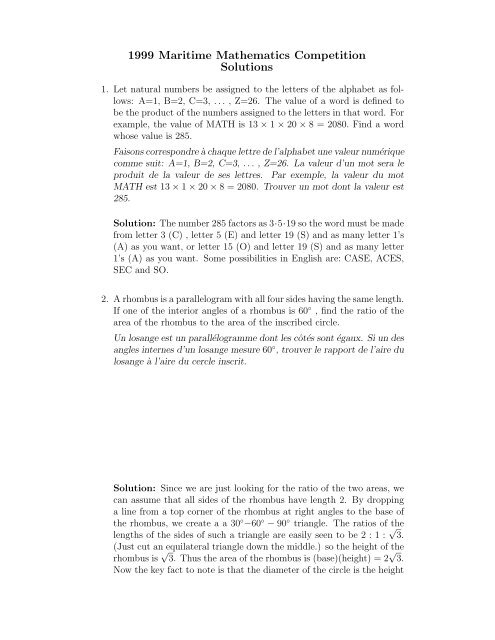
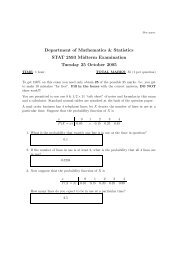
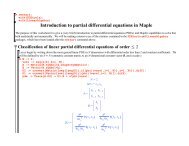
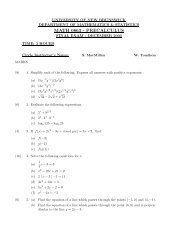

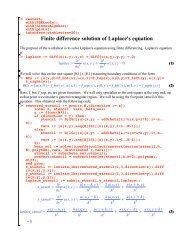
![1]] CHAPTER 2 LIMITS AND DERIVATIVES](https://img.yumpu.com/40053548/1/190x245/1-chapter-2-limits-and-derivatives.jpg?quality=85)
